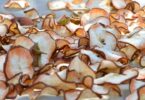Find out how to dry nectarines at home.
Even if you have the money to spend, adding more plant-based food into your family’s regular fare is a good investment in fighting against the growing tide of obesity and related diseases. However, stocking up on and storing these foods to make them last over several days is a problem.
Thankfully there is dehydration. Drying nectarines help preserve the fruits’ nutritional content, on top of giving you a tasty, healthy snack option throughout the year.
READ ALSO: How to Dehydrate Food Successfully: A Beginner’s Guide
Easy Methods of Drying Nectarines
General procedures
- Choose only pieces of nectarine that are fully ripened. To know which ones fit the criterion, give each piece a squeeze. You will know that the fruit is completely ripe when it gives in a bit, but doesn’t become mushy when squeezed.
- Peel and thoroughly wash the nectarines.
- Halve and pit the fruits.
- Pretreat the nectarine slices with ascorbic acid or with citric acid/lemon juice. This will help prevent discoloration and browning of your nectarines. You can use sulfur compounds if preferred. However, if you are asthmatic, it can cause an allergic reaction. When using ascorbic acid, just add a quart of cold water to 2 ½ tbsp. of ascorbic acid. Soak the fruit slices. When using lemon juice, just add a quart of water to 1 tbsp. of juice. If you prefer sulfur, mix 1 quart of cold water to 1 tbsp. sodium metabisulfite.
- Slice the nectarines directly into the solution. You should get around 6 slices for each half.
Choose your preferred or the available drying method: using a dehydrator, using an oven, or drying under the sun.
Drying nectarines with a dehydrator
Using a dehydrator to dry nectarines is convenient and fast.
- Lay the nectarine slices on the dehydrator trays individually. Make sure they are not touching one another.
- Set the heat at 135F (60C) for around 12 to 18 hours.
- Spray some oil on the nectarine slices to make it easier to take the dried fruits out of the dehydrator trays later.
- Remove the dried nectarines from the dehydrator trays.
Let it cool and store properly. A proper way of storage will be discussed in a later section of this post.
Drying nectarines in the oven
This can be a quick way of dehydrating nectarines. However, there is a risk of burning the fruits if you use a higher heat setting than necessary, or if you leave the fruit slices in the oven for too long.
- Lay the slices of nectarine individually on baking sheets. Make sure they are not touching one another.
- Set the oven to the lowest possible heat setting. This is typically around 150F (65C).
- Check the nectarine slices for dryness after every hour. The whole process should last around 8 hours.
- You can keep the oven door slightly open for a better air circulation
- Spray some oil on the nectarine slices to make it easier to take the dried fruits out of the baking sheets later.
- Remove the dried fruits from the baking sheets.
Let them cool and store the dehydrated nectarines properly to prolong the shelf life.
Sun-drying nectarines
This method will work only when the temperature in your area reaches 85F by noontime, and the humidity is under 60%. It also takes a much longer time to completely dry nectarines outdoors – at least three times longer than it takes using an oven or food dehydrator.
You will only waste your efforts, not to mention, the nectarines if you live in a place that doesn’t get enough sun during the day. Sun-drying usually also results in nutrient loss.
How to Store Dried Nectarines
After the dehydration process, dried nectarines must be kept in sealed, air-tight containers under room temperature. These include plastic or glass jars, plastic containers with lids, zipper bags, or any similar air-tight container. Oxygen will dry the nectarines out further, turning them as hard as rocks.
Never store your dried fruit near any source of heat or in direct sunlight. Ideally, room temperature must be at or a little under 68F. If the ambient air conditions in your home are humid in general, it may be a wise move to refrigerate your dried nectarines.
You can even freeze your dried fruits to make them last longer. If you are ready to use them, don’t worry because it doesn’t take too long to defrost the fruits after taking them out of the freezer.
READ ALSO: How to Store Dried Fruits at Home
Benefits of Dehydrating Nectarines
Following are the main benefits of using dehydrated nectarines:
- Dehydrated nectarines taste great – Only the moisture is removed; the taste and flavor are retained.
- You help reduce food waste and extend the food’s shelf life – Your excess stock of nectarines will not go to waste.
- You create 100% natural and healthy food – You’re sure it’s natural since it only contains one ingredient – nectarines.
- You save on cost – Store-bought food – even the organic dehydrated ones – are usually highly over-priced.
- You save on storage space – Dehydrated nectarines will only take up 1/6 of the space you would need to keep fresh nectarines.
- Dried nectarines are very portable – When dehydrated, nectarines become lightweight and compact that you can easily pack when you travel.
- Dried nectarines are versatile and flexible – You can enjoy dried nectarines as is as snacks or with other dried fruits.
- When stored properly, preservation is safe – There is minimal risk of spoiling and bacteria.
Under the proper storage conditions, your dried fruit will be good for a full year, even longer in some cases. Drying and storing nectarines is a good way to enjoy your favorite fruit – with most nutrients intact – anytime and any day of the year.





